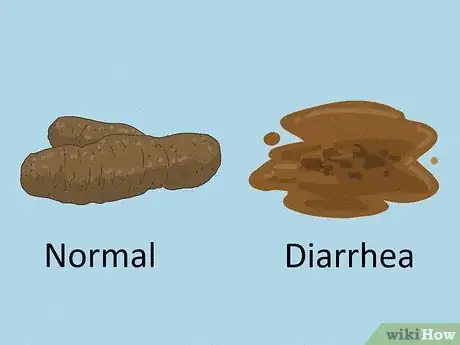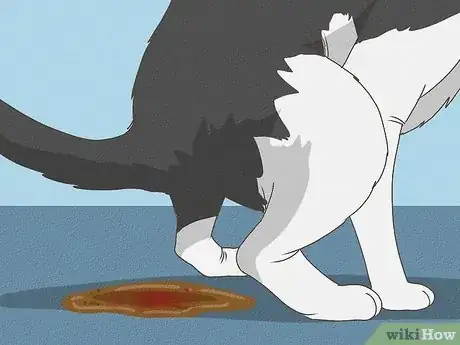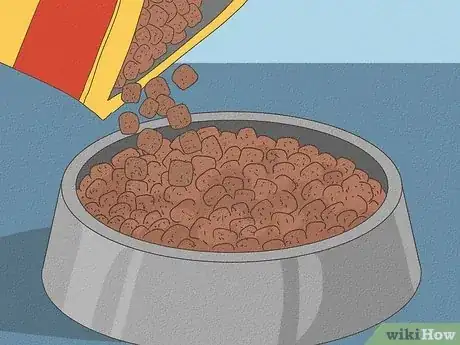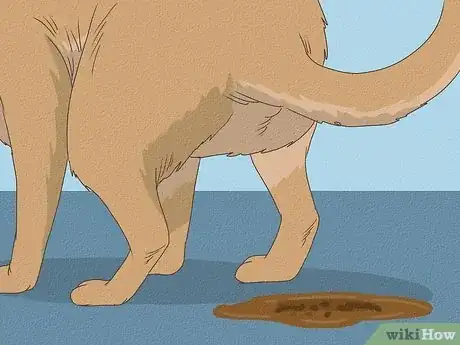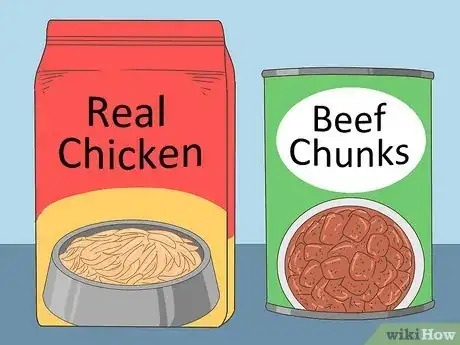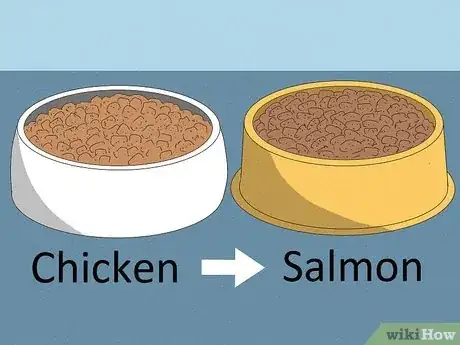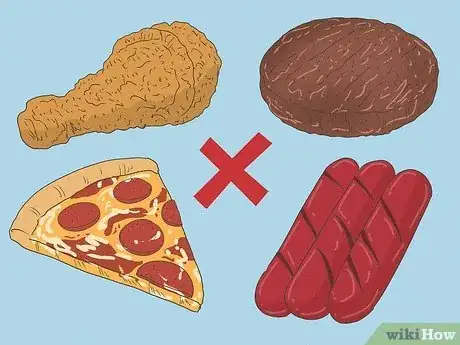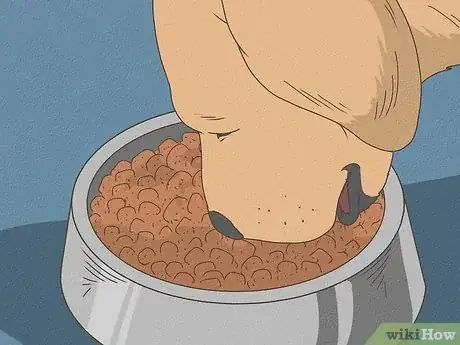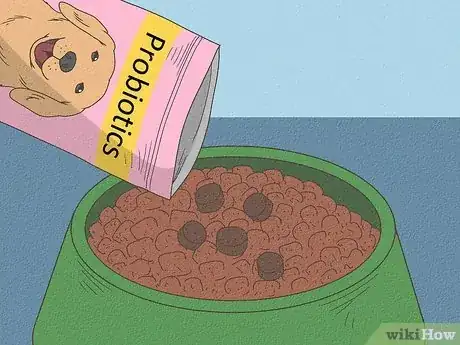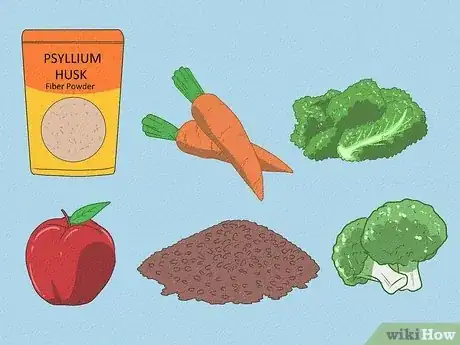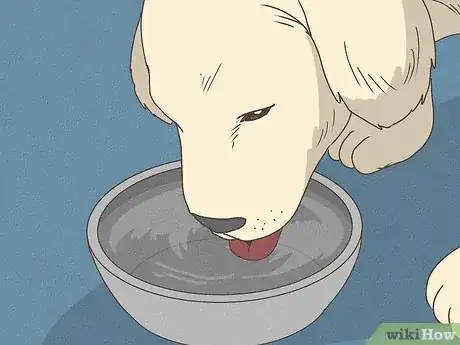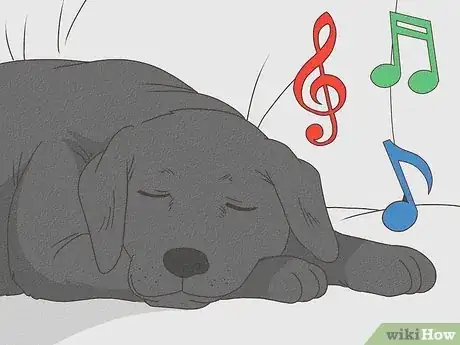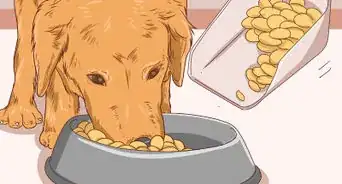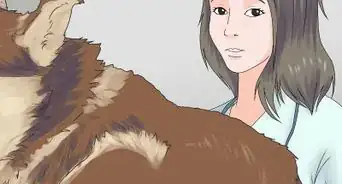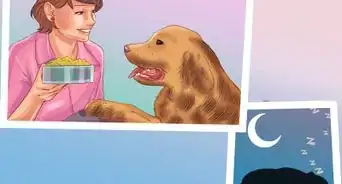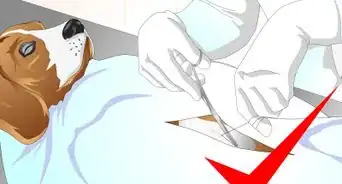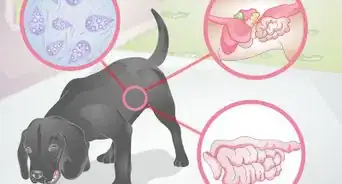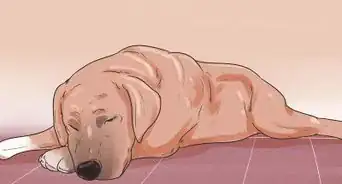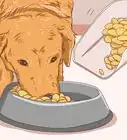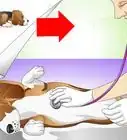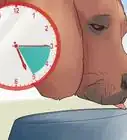This article was co-authored by Pippa Elliott, MRCVS and by wikiHow staff writer, Eric McClure. Dr. Elliott, BVMS, MRCVS is a veterinarian with over 30 years of experience in veterinary surgery and companion animal practice. She graduated from the University of Glasgow in 1987 with a degree in veterinary medicine and surgery. She has worked at the same animal clinic in her hometown for over 20 years.
There are 16 references cited in this article, which can be found at the bottom of the page.
wikiHow marks an article as reader-approved once it receives enough positive feedback. This article has 18 testimonials from our readers, earning it our reader-approved status.
This article has been viewed 724,343 times.
It can be worrying if your dog is having loose stools (not to mention difficult to clean up!). Fortunately, occasional soft stools are totally normal in dogs. Still, we've got a variety of expert-backed tips to help you firm up your dog’s bowel movements and put an end to this issue. We've also go advice on when loose stools become a problem that requires a trip to the vet.
Things You Should Know
- Switch to high-fiber dog food, or add 1 teaspoon of psyllium husk fiber powder to your dog's food once per day.
- Consider adding probiotics to your dog’s diet, which can improve soft stools.
- Feed your dog a high-quality diet full of natural ingredients. In many cases, switching to a blander diet can help with stool issues.
- See a vet if your dog’s loose stools don’t improve or if your dog is having diarrhea.
Steps
Taking an Initial Assessment
-
1Confirm your dog has soft stools and not diarrhea. A soft stool is bulky and formed, and you should be able to pick it up for poop disposal. Diarrhea is all liquid, which makes it impossible to pick up. Diarrhea is usually an indicator of a potential medical issue, as your dog is trying to eject toxins. Soft stools, on the other hand, are usually a non-medical issue. Just make sure your pup is healthy before trying to solve this yourself![1]
- Soft stool is almost always no biggie, so take a deep breath if you’re stressed out your dog’s poop has suddenly turned soft.
-
2See a veterinarian if your dog needs treatment for diarrhea. A single instance of diarrhea followed by normal eating, drinking, and behavior is probably nothing. But if the diarrhea persists or there are any other symptoms associated with the diarrhea, you should take your dog to a vet as soon as possible.[2] Potential symptoms that require a vet visit include:
- Blood, mucus, or materials that look like seeds in your dog’s stool.
- Vomiting, lethargy, or excessive panting.
- Whimpering, sudden aggression, or crouching over around their tummy.
- If your dog has zero additional symptoms, don't feed them for 24 hours, but make sure plenty of fresh water is available. After 24 hours, introduce a bland diet such as cooked chicken and boiled white rice.
Advertisement -
3Wait a day or so if there were recent changes to your dog’s diet. Have you recently changed your dog’s diet? Did you switch up the brand of treats, or reward them with a little piece of cheese? If so, your dog’s poop should return to normal in no time. Just monitor your dog’s behavior and stool. If things return to normal, write this off as a one-time thing.[3]
- If you do want to change your dog’s diet, switch their diet gradually over time. Start with ¼ new food and ¾ the old food. Then, slowly change the ratio over time.[4]
-
4Don’t worry about occasional loose stool. No dog is going to have 100% perfect stool every single time they go to the bathroom. It’d actually be strange if your dog never had a loose stool. If your dog has a loose bowel movement 1-2 times a week, it’s frankly no big deal.[5]
- This is easy to write off. Dogs can have loose stool if they’re slightly overactive while they digest, or they get a little stressed out before they go to the bathroom.
Dietary Changes
-
1Choose a well-balanced diet full of natural ingredients. Look for a dry or wet food that lists meat as the main ingredient. It should say “chicken,” or “beef,” and not “meat derivatives,” or something like that. If you see corn listed as a top ingredient, it’s probably not the best option. Food coloring is another big sign you aren’t looking at a high quality product.[6]
- Choose white meats with low fat contents like chicken, turkey, or fish.
- Look for a low number of ingredients, since the food is likely to contain less processed ingredients and fewer preservatives.
- Look for the carbohydrate in the form of rice, wheat, oats, or barley, rather than soy or soya products.
-
2Switch brands to change the main ingredient in your dog’s food. Dogs can have food allergies and food intolerances just like people can. If you’re feeding your pup a diet with chicken as the main ingredient, try switching foods to a turkey or salmon variety. If the other big ingredient is rice, switch to something oat-based.[7]
- Every dog is unique, and some dogs just won’t process some ingredients correctly.
- You can try switching from wet to dry food and vice versa, too. However, the ingredients in the food matter more than the type of food if your dog has loose stools.
-
3Avoid giving your dog high-fat treats or foods. Stay away from fats that easily become rancid. Do not give fried fast foods to your dog. Usually fried commercial fast foods are fried using palm oil; this oil is hard to digest and can easily turn rancid. Bad fats can form a layer in the intestine, causing your dog to have watery stools.[8]
- This doesn’t mean fat in itself is bad. A dog’s food should be 5-15% fat.
-
4Feed your dog a bland food product if the soft stools persist. Bland dog foods refer to products that only contain a handful of ingredients. Usually, it’ll be something like soft cooked rice, lean ground pork, and a binding agent/preservative. These diets are super easy for dogs to digest. Just look for food that’s labelled “bland,” “simple,” or “basic.”[9]
- Many of these foods will say “prescription” on the label. These may be prescription only if you buy them locally, but you can 100% order them online.
Lifestyle Changes & Supplements
-
1Pay closer attention to your dog and what they eat. If you’ve got a pup with a predilection for snacking on leaves and other garbage they find, catching them in the act is a good way to prevent stomach issues. Keep an eye on your dog when you’re walking them and don’t let them hang out under the dinner table when you and your family eat.[10]
- If your dog is home alone during the day, consider installing baby gates to restrict them to one part of the house. Keep the floors in that area pristine, and you’ll ensure your dog doesn’t eat up anything they shouldn’t have.
-
2Try giving your dog probiotics to see if that helps. The gut relies on a population of bacteria to aid digestion. If your dog has had a poor diet and soft stools for a while, then the bowel can get an overgrowth of "unhelpful" bacteria. Try giving your dog probiotic treats every few days to see if that helps improve things.[11]
- Do not give your dog human probiotics. People and dogs have different gut biomes.
- There’s some evidence that probiotics won’t help a dog’s gut in every situation, so if you don’t see any improvement after a few weeks, feel free to stop the probiotics.
-
3Add fiber to your dog's diet. Some dogs with soft stools benefit from increased fiber in their diet. Fiber helps soak up fluid like a sponge and can help normalize the feces, dry up diarrhea, or firm up stool. Either switch to a high-fiber diet or sprinkle a teaspoon of psyllium husk fiber powder in with your dog’s breakfast every day.[12]
- Believe it or not, you can give your dog psyllium husk meant for humans. The most popular brand is Metamucil, but any brand will work. Just avoid the husk with sugar added to it for flavor.
-
4Make sure your dog always has fresh water. Dogs with soft stools lose extra water because of the raised fluid content, so it is important for them to have free access to clean drinking water to replace this lost fluid. Wash and clean your dog’s water bowl at least every other day and make sure that they always have fresh, clean water.[13]
- If your dog won’t drink standing water, consider upgrading to a water fountain for dogs.
-
5Increase the amount of time between your dog’s meals. Most dogs need 6-8 hours to fully digest whatever is in their stomach. If you feed your dog at 8 am and then 3 pm, try moving dinner to 5 or 6 pm. If you feed your dog 3 times a day, try switching to 2 larger meals a day.[14]
- A lot of dogs do a lot better with 2 meals a day, believe it or not.
-
6Keep your pup as stress-free as possible. If taking a bath or hearing fireworks is stressful for your dog, wait a few days and observe if the stool firms up. In some dogs there is a strong link between stress and digestive disturbances. If this is the case, reduce their overall stress in order to firm their stools up.[15]
- Stress causes the physiology of the intestines to become more basic (acidic intestines favor the good bacteria), making it harder for your dog to process foods.
-
7Take your dog to the veterinarian if soft stool persists. While a lot of cases of soft stool can be cleared up simply through changes to diet, it can be a sign of other health problems. If your dog continues to pass soft stools, even after you have tried changing their diet, take them to a vet to get checked out.[16]
Expert Q&A
-
QuestionNone of the suggestions in the article are working. What should I do?
 Pippa Elliott, MRCVSDr. Elliott, BVMS, MRCVS is a veterinarian with over 30 years of experience in veterinary surgery and companion animal practice. She graduated from the University of Glasgow in 1987 with a degree in veterinary medicine and surgery. She has worked at the same animal clinic in her hometown for over 20 years.
Pippa Elliott, MRCVSDr. Elliott, BVMS, MRCVS is a veterinarian with over 30 years of experience in veterinary surgery and companion animal practice. She graduated from the University of Glasgow in 1987 with a degree in veterinary medicine and surgery. She has worked at the same animal clinic in her hometown for over 20 years.
Veterinarian Dogs can have a soft stool for a number of reasons. The article focuses on the causes you can control at home such as diet, fiber content, and food intolerance. However, if a dog has a health problem such as bacterial overgrowth in the bowel, a deficiency of digestive enzymes, inflammatory bowel disease, or even bowel cancer, then this requires specific pharmaceutical intervention and the dog should see a vet.
Dogs can have a soft stool for a number of reasons. The article focuses on the causes you can control at home such as diet, fiber content, and food intolerance. However, if a dog has a health problem such as bacterial overgrowth in the bowel, a deficiency of digestive enzymes, inflammatory bowel disease, or even bowel cancer, then this requires specific pharmaceutical intervention and the dog should see a vet. -
QuestionMy dog had Giardia but is now free from it. Her stools were firm, but a week later have become soft again. Should I repeat another round of Safeguard?
 Pippa Elliott, MRCVSDr. Elliott, BVMS, MRCVS is a veterinarian with over 30 years of experience in veterinary surgery and companion animal practice. She graduated from the University of Glasgow in 1987 with a degree in veterinary medicine and surgery. She has worked at the same animal clinic in her hometown for over 20 years.
Pippa Elliott, MRCVSDr. Elliott, BVMS, MRCVS is a veterinarian with over 30 years of experience in veterinary surgery and companion animal practice. She graduated from the University of Glasgow in 1987 with a degree in veterinary medicine and surgery. She has worked at the same animal clinic in her hometown for over 20 years.
Veterinarian Giardia can stick to the dog's coat, bedding, or carpets, so the dog may have accidentally reinfected herself. Provided she is otherwise well, then another course of Safeguard is a good idea. But in order to prevent reinfection occurring again, bathe the dog, wash the bedding, and steam clean all soft furnishings.
Giardia can stick to the dog's coat, bedding, or carpets, so the dog may have accidentally reinfected herself. Provided she is otherwise well, then another course of Safeguard is a good idea. But in order to prevent reinfection occurring again, bathe the dog, wash the bedding, and steam clean all soft furnishings.
Warnings
- Take your dog to a vet as soon as possible if your dog has frequent diarrhea or your dog has a loose stool and blood, mucus, or foreign objects in their stool. Vomiting, lethargy, excessive panting, whimpering, or frequent crouching also warrant an emergency visit to the vet.[17]⧼thumbs_response⧽
References
- ↑ https://www.ctvsh.com/services/blog/get-scoop-what-your-pets-poop-telling-you
- ↑ https://vcahospitals.com/know-your-pet/common-emergencies-in-dogs
- ↑ https://www.caninejournal.com/dog-poop-color/
- ↑ https://www.akc.org/expert-advice/nutrition/right-way-switch-dog-foods/
- ↑ https://www.preventivevet.com/dogs/what-dogs-poo-can-tell-you-about-their-health
- ↑ https://www.petmd.com/dog/nutrition/evr_dg_the_best_food_for_dogs
- ↑ https://www.greatpetcare.com/dog-health/the-hidden-dangers-of-loose-stools-in-dogs/
- ↑ https://www.petmd.com/dog/nutrition/fats-for-dogs
- ↑ https://vcahospitals.com/know-your-pet/blah-blah-and-more-blah-bland-diet-instructions-for-dogs-and-cats
- ↑ https://www.insider.com/guides/pets/how-to-stop-dog-eating-trash
- ↑ https://www.akc.org/expert-advice/nutrition/probiotics-for-dogs/
- ↑ https://www.whole-dog-journal.com/health/metamucil-for-dogs/
- ↑ https://www.petplace.com/article/dogs/pet-behavior-training/dog-behavior-training/dog-behavior-problems/why-is-my-dog-not-drinking-water/
- ↑ https://vcahospitals.com/know-your-pet/feeding-times-and-frequency-for-your-dog
- ↑ http://pets.thenest.com/can-feed-dog-firm-up-his-stool-4353.html
- ↑ https://www.akc.org/expert-advice/health/doggie-diarrhea/
- ↑ https://vcahospitals.com/know-your-pet/common-emergencies-in-dogs
About This Article
To firm up your dog's stool, try switching to a high-quality, low-fat dog food that lists meat as the main ingredient. Also, if your dog currently eats wet food, gradually replace the wet food with dry food until your dog is only eating dry food, which can help make its stools firmer. You can also try adding some fiber to your dog's diet by mixing a little oat or wheat bran into its food. If your dog's soft stools persist, take it to the vet to rule out any other health problems. To learn how to help your dog if it has diarrhea instead of soft stools, keep reading!
